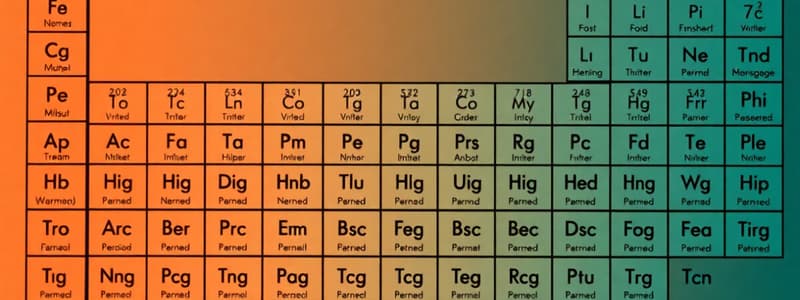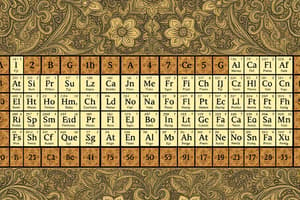Podcast
Questions and Answers
What type of chemical bond involves the sharing of electrons between atoms?
What type of chemical bond involves the sharing of electrons between atoms?
- Covalent bond (correct)
- Metallic bond
- Ionic bond
- Hydrogen bond
Which process is primarily used to separate components of a mixture based on differences in boiling points?
Which process is primarily used to separate components of a mixture based on differences in boiling points?
- Distillation (correct)
- Chromatography
- Evaporation
- Filtration
Which of the following reactions is classified as a redox reaction?
Which of the following reactions is classified as a redox reaction?
- Combustion of fuels (correct)
- Precipitation
- Acid-base neutralization
- Metallization
Which substance can act both as an acid and a base in chemical reactions?
Which substance can act both as an acid and a base in chemical reactions?
What is the primary outcome of acid-base reactions?
What is the primary outcome of acid-base reactions?
Which elements are known for their lack of reactivity due to having full valence electron shells?
Which elements are known for their lack of reactivity due to having full valence electron shells?
What is a characteristic of transition metals?
What is a characteristic of transition metals?
Which of the following describes alkenes?
Which of the following describes alkenes?
What does the particle/kinetic theory state?
What does the particle/kinetic theory state?
Which property is NOT associated with gases in the atmosphere?
Which property is NOT associated with gases in the atmosphere?
Which of the following compounds contains a carboxyl group?
Which of the following compounds contains a carboxyl group?
What happens during diffusion?
What happens during diffusion?
Which statement accurately describes the classification of elements in the periodic table?
Which statement accurately describes the classification of elements in the periodic table?
What is the primary method used to analyze the components of a mixture based on their movement through a medium?
What is the primary method used to analyze the components of a mixture based on their movement through a medium?
Which type of reaction involves the transfer of electrons leading to changes in oxidation states?
Which type of reaction involves the transfer of electrons leading to changes in oxidation states?
What term describes a solution with a pH of 7, indicating an equal concentration of acids and bases?
What term describes a solution with a pH of 7, indicating an equal concentration of acids and bases?
Which process is primarily responsible for the gradual deterioration of metals when exposed to moisture and oxygen?
Which process is primarily responsible for the gradual deterioration of metals when exposed to moisture and oxygen?
What kind of bonds are formed when atoms completely transfer electrons to achieve stability?
What kind of bonds are formed when atoms completely transfer electrons to achieve stability?
What property differentiates metals from non-metals?
What property differentiates metals from non-metals?
Which of the following compounds is an example of an alkane?
Which of the following compounds is an example of an alkane?
What is a primary characteristic of noble gases?
What is a primary characteristic of noble gases?
In which state of matter do particles have the most energy?
In which state of matter do particles have the most energy?
Which of the following describes the behavior of gases?
Which of the following describes the behavior of gases?
What defines the valency of an element?
What defines the valency of an element?
Which atmospheric gas is most abundant in Earth's atmosphere?
Which atmospheric gas is most abundant in Earth's atmosphere?
What is the primary function of esters in organic chemistry?
What is the primary function of esters in organic chemistry?
Flashcards
Metals
Metals
Elements that are good conductors of electricity and heat.
Non-metals
Non-metals
Elements that are poor conductors of electricity and heat.
Transition Metals
Transition Metals
Elements located in the center of the periodic table, known for forming colorful compounds and having variable oxidation states.
Noble Gases
Noble Gases
Signup and view all the flashcards
Alkane
Alkane
Signup and view all the flashcards
Alkene
Alkene
Signup and view all the flashcards
Alcohol
Alcohol
Signup and view all the flashcards
Carboxylic Acid
Carboxylic Acid
Signup and view all the flashcards
Acids
Acids
Signup and view all the flashcards
Bases
Bases
Signup and view all the flashcards
Neutral Solutions
Neutral Solutions
Signup and view all the flashcards
Redox Reactions
Redox Reactions
Signup and view all the flashcards
Reactivity Series
Reactivity Series
Signup and view all the flashcards
What are mixtures?
What are mixtures?
Signup and view all the flashcards
How are mixtures separated?
How are mixtures separated?
Signup and view all the flashcards
What are chemical bonds?
What are chemical bonds?
Signup and view all the flashcards
What are ionic bonds?
What are ionic bonds?
Signup and view all the flashcards
What are covalent bonds?
What are covalent bonds?
Signup and view all the flashcards
Periodic Table: Periods & Groups
Periodic Table: Periods & Groups
Signup and view all the flashcards
Transition Metals: Colorful Compounds
Transition Metals: Colorful Compounds
Signup and view all the flashcards
Diffusion: Spreading Out
Diffusion: Spreading Out
Signup and view all the flashcards
Matter: States and Properties
Matter: States and Properties
Signup and view all the flashcards
Atomic Structure: Protons, Neutrons & Electrons
Atomic Structure: Protons, Neutrons & Electrons
Signup and view all the flashcards
Electron Configuration: Electron Distribution
Electron Configuration: Electron Distribution
Signup and view all the flashcards
Valency: Combining Power
Valency: Combining Power
Signup and view all the flashcards
Particle/Kinetic Theory: Tiny Particles in Motion
Particle/Kinetic Theory: Tiny Particles in Motion
Signup and view all the flashcards
Study Notes
Periodic Table
- Metals and non-metals are categorized based on their conductivity; metals conduct electricity and heat well, while non-metals do not.
- Transition metals are found in the center of the periodic table, forming colorful compounds and having variable oxidation states.
- Noble gases are in group 18 and are unreactive due to full valence electron shells.
- Trends in properties of elements are observed across rows (periods) and columns (groups).
- Periods and groups classify elements based on their properties.
IUPAC Naming and Classification
- Alkanes are saturated hydrocarbons with single bonds between carbon atoms (e.g., methane, ethane).
- Alkenes are unsaturated hydrocarbons with at least one double bond between carbon atoms (e.g., ethene).
- Alcohols are organic compounds containing a hydroxyl group (-OH) (e.g., ethanol).
- Carboxylic acids are organic acids containing a carboxyl group (-COOH) (e.g., acetic acid).
- Esters are organic compounds derived from carboxylic acids and alcohols, often with pleasant smells (e.g., ethyl acetate).
The Atmosphere
- Gas properties are defined and measured by pressure, volume, and temperature.
- Earth's atmosphere is a mix of gases (e.g., nitrogen, oxygen).
- Testing and treatment methods analyze air quality and purification techniques are used to purify air.
- Extraction, emission, and environmental impacts cover processes, pollution release, and effects on the environment.
Matter
- Matter exists in solid, liquid, and gas forms. Characteristics include density and boiling point.
- Particle/kinetic theory suggests that matter consists of moving particles.
- Diffusion is the spreading of particles from high to low concentration.
- Atoms are made up of protons, neutrons, and electrons. Electron configurations describe electron distribution within atomic orbitals.
- Valency refers to an element's combining capacity, usually involving electrons.
Bonding
- Atoms connect via ionic, covalent, and metallic bonds.
- Chemical formulas and reactions involve atomic symbols and ratios.
- Chemical kinetics studies reaction rates and influencing factors.
- Equilibrium reactions reach a balance between forward and reverse reactions.
- Energy changes in reactions can be endothermic (absorbing heat) or exothermic (releasing heat).
- Combustion reactions involve burning fuels to release energy (often releasing carbon dioxide and water).
Types of Chemical Reactions
- Acids donate protons (H+), and bases accept protons.
- Neutral solutions have a pH of 7.
- Acid/base reactions produce water and salts.
- Redox reactions involve electron transfer (oxidation and reduction).
- Reactivity series lists metals in order of reactivity, from highest to lowest. Metal extraction retrieves metals from their ore.
- Corrosion is a metal's gradual deterioration by chemical reactions, typically happening in the environment.
Electrochemical Cells
- Electrochemical cells transform chemical energy into electrical energy via redox reactions.
Studying That Suits You
Use AI to generate personalized quizzes and flashcards to suit your learning preferences.




